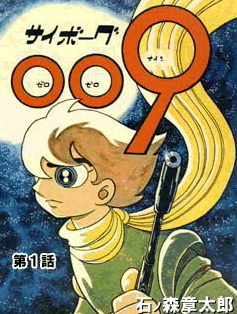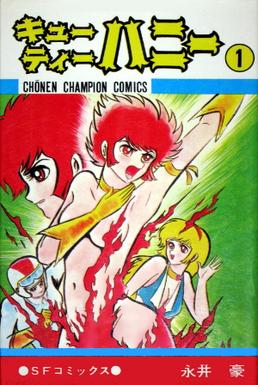
Cyborg 009 is a Japanese science fiction manga created by Shotaro Ishinomori. It was serialized in many different Japanese magazines, including Monthly Shōnen King, Weekly Shōnen Magazine, Shōnen Big Comic, COM, Shōjo Comic, Weekly Shōnen Sunday, Monthly Shōnen Jump, and Monthly Comic Nora. In 2012, comiXology acquired the digital distribution rights to Shotaro Ishinomori's catalogue, including Cyborg 009.

Horipro is a large Japanese talent agency.

The Japan Academy Prize (日本学士院賞) is a prize awarded by the Japan Academy in recognition of academic theses, books, and achievements.

Business Jump, was a Japanese seinen manga anthology published by Shueisha under the Jump line of magazines. The manga of Business Jump were published under the "Young Jump Comics" line. This magazine's mascot was an anthropomorphic, Western-style mouse illustrated by Susumu Matsushita.

Blue SWAT is a Japanese television show and the thirteenth installment in the Metal Hero Series franchise. It ran from January 30, 1994 to January 29, 1995 for a total of 51 episodes and one theatrical film, aired as part of the 1994 Manga Matsuri, which compiled episodes 1 and 2. Blue SWAT deviated from the Metal Hero trend by using a realistic vibe for the series instead of fantastic, over-the-top action by focusing on the martial arts and gunplay aspects of the series. While the mood of the series appealed to the genre's adult fanbase and older viewers, the show was not well received by children, which resulted in a change into a lighter tone midway through the series. The Blue SWAT team later appeared for a special team-up in the final episodes of Juukou B-Fighter.
Events in the year 1999 in Japan. It corresponds to the year Heisei 11 in the Japanese calendar.
1986 inJapan was the first year of the Japanese asset price bubble.
Established in 2005, Level Comics is a division of Elex Media Komputindo that publishes seinen, shonen with a strong violence, and also josei manga in Indonesia. Elex Media Komputindo has been publishing manga in Indonesia since 1990. As the readers of manga became more mature, Elex Media decided to start a new division that was more suitable and enjoyable for older manga readers. The first releases of Level Comics were Homunculus by Hideo Yamamoto, Vagabond by Takehiko Inoue, 20th Century Boys by Naoki Urasawa and X by Clamp.
Go Nagai is a prolific Japanese manga artist who has written, illustrated, or otherwise contributed to over 360 manga titles since his professional debut in 1967 with Meakashi Polikichi. Specializing in science fiction, fantasy, horror, and erotica, he is best known for creating the seminal works Cutie Honey, Devilman, and Mazinger Z in the 1970s.
Events in the year 1952 in Japan.
Events in the year 1929 in Japan. It corresponds to Shōwa 4 (昭和4年) in the Japanese calendar.
Events from the year 1955 in Japan.

Aoi is a 2000 Japanese historical drama television series and the 39th NHK taiga drama. The series respectively stars Masahiko Tsugawa, Toshiyuki Nishida, and Onoe Tatsunosuke II as the first three Tokugawa shōguns. It aired from January 9 to December 17, 2000, and ran for a total of 49 episodes.

Cutie Honey is a Japanese shōnen manga series written and illustrated by Go Nagai. First appearing in Weekly Shōnen Champion's 41st issue of 1973, the series ran until April 1974. It follows an android girl named Honey Kisaragi, who transforms into the busty, red or pink-haired heroine Cutie Honey to fight against the assorted villains that threaten her or her world. One of the trademarks of the character is that the transformation involves the temporary loss of all her clothing in the brief interim from changing from one form to the other. According to Nagai, she is the first female to be the protagonist of a shōnen manga series.

Kiyoshi Nagai, better known by the pen name Go Nagai, is a Japanese manga artist and a prolific author of science fiction, fantasy, horror and erotica. He made his professional debut in 1967 with Meakashi Polikichi, but is best known for creating popular 1970s manga and anime series such as Cutie Honey, Devilman and Mazinger Z. He is credited with creating the super robot genre and for designing the first mecha robots piloted by a user from within a cockpit with Mazinger Z, and for helping pioneer the magical girl genre with Cutie Honey, the post-apocalyptic manga/anime genre with Violence Jack, and the ecchi genre with Harenchi Gakuen. In 2005, he became a Character Design professor at the Osaka University of Arts. He has been a member of the Tezuka Osamu Cultural Prize's nominating committee since 2009.
The following is an overview of 2015 in manga. It includes winners of notable awards, best-sellers, title debuts and endings, deaths of notable manga-related people as well as any other relevant manga-related events. For an overview of the year in comics from other countries, see 2015 in comics.








